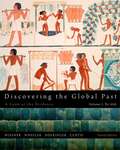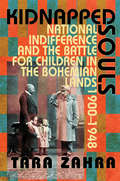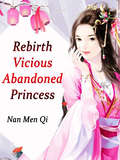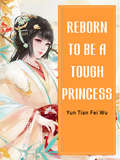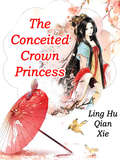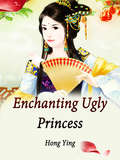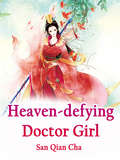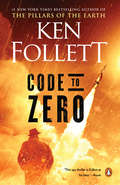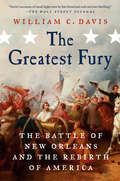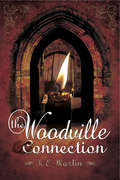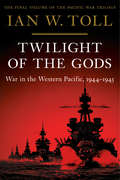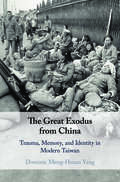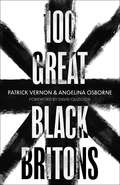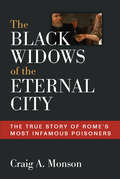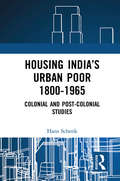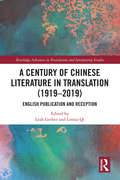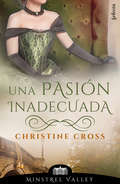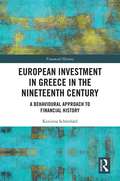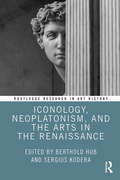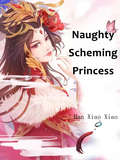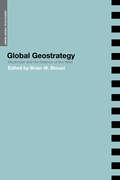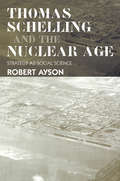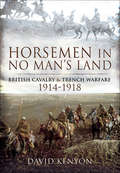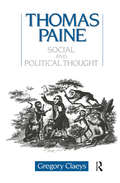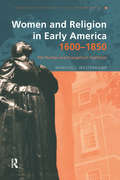- Table View
- List View
Discovering the Global Past: A Look at the Evidence, Volume I: To 1650
by Merry E. Wiesner William Bruce Wheeler Franklin M. Doeringer Kenneth R. CurtisNIMAC-sourced textbook
Kidnapped Souls: National Indifference and the Battle for Children in the Bohemian Lands, 1900–1948
by Tara ZahraThroughout the nineteenth and into the early decades of the twentieth century, it was common for rural and working-class parents in the Czech-German borderlands to ensure that their children were bilingual by sending them to live with families who spoke the "other" language. As nationalism became a more potent force in Central Europe, however, such practices troubled pro-German and pro-Czech activists, who feared that the children born to their nation could literally be "lost" or "kidnapped" from the national community through such experiences and, more generally, by parents who were either flexible about national belonging or altogether indifferent to it. Highlighting this indifference to nationalism—and concerns about such apathy among nationalists—Kidnapped Souls offers a surprising new perspective on Central European politics and society in the first half of the twentieth century.Drawing on Austrian, Czech, and German archives, Tara Zahra shows how nationalists in the Bohemian Lands worked to forge political cultures in which children belonged more rightfully to the national collective than to their parents. Through their educational and social activism to fix the boundaries of nation and family, Zahra finds, Czech and German nationalists reveal the set of beliefs they shared about children, family, democracy, minority rights, and the relationship between the individual and the collective. Zahra shows that by 1939 a vigorous tradition of Czech-German nationalist competition over children had created cultures that would shape the policies of the Nazi occupation and the Czech response to it. The book's concluding chapter weighs the prehistory and consequences of the postwar expulsion of German families from the Bohemian Lands.Kidnapped Souls is a significant contribution to our understanding of the genealogy of modern nationalism in Central Europe and a groundbreaking exploration of the ways in which children have been the objects of political contestation when national communities have sought to shape, or to reshape, their futures.
Rebirth: Volume 1 (Volume 1 #1)
by Nan MenQiShe was the infamous trash of Mo Jing. On the day of their wedding, her fiance had married another woman and even knocked her off the platform with a single palm. He opened his eyes again and returned to the Nirvana Realm! Scoundrel, Pressing white flowers, Fighting the Wicked Mother, Beating up slaves. Anyone in the world who bullied her, humiliated her, or slandered her would be repaid a hundredfold! Grass bag? She was the one who won the war of words and became famous just like that. Trash? She was the one who planned everything and made decisions! His fiancé was going to turn back? I'm sorry, but I've never been able to eat it. However... "Brother, you are famous for being sick, can you not meddle blindly? "Where are you staying!" A trace of a demonic smile flashed across his cold eyes. "My beloved concubine, whether This King is in good health or not, we'll only know if you 'try' it out."
Reborn To Be A Tough Princess: Volume 1 (Volume 1 #1)
by Yun TianFeiWuAfter years of hellish torture, she finally understood a truth. If you make yourself an ass, if you ride a horse, you may not get what you really mean. The kindly adopted sisters used her as a stepping stone, robbed her fiance, and raided her home. The man with whom she had her heart set on him had killed her father and brother in order to ascend the throne, and had made her reviled as a usurper. She walked through her own flesh and blood, rose from the ashes, and went back to the past. In this life, she will always be looking forward to seeing more clearly, becoming a persecuting dog as she decides life and death, and protecting her father and brother. Who knows, evil evil king pester endlessly, will her favor in the palm. Who dare to deceive her, one to destroy one, to destroy one pair. rebirth PK through the white lotus flower, see full of hatred if she turned over and decided, who is the real protagonist in this life! Every morning 9:00 on time update, I hope you subscribe more, support legal reading, thanks dear friends support! (づ  ̄  ̄ 3) づ 【 fog fog's book launches the curse the demon princess survival guide "collection, first check!"
The Conceited Crown Princess: Volume 1 (Volume 1 #1)
by Ling HuQianXieOnce transmigrated, she became the trash + ugly girl that everyone ridiculed. Ugly girl? She touched her face, a trace of a charming smile curling up at the corner of her lips. "I don't think so …" Trash? When did these two words become synonymous with my Evil Phoenix? Heh — Her cold eyes opened, and she spoke in a cold voice, "I shall return the humiliation that you have suffered one day for me to pay me back in your stead from now on …" Possessing one's soul, the world suddenly changed to cure the poison. Abandoning one's fiance, abusing trash of a girl and dominating cold man. Let's see how she can reverse the situation and shine in a foreign world!
Enchanting Ugly Princess: Volume 1 (Volume 1 #1)
by Hong YingEveryone called her stupid, laughed at her because she was ugly, and bullied her for being stupid! She was the grand young mistress of the Duke's Mansion, but she dared to shit on her head even when she was a servant! In the 21st century, the policewoman came over, and the scenery was beautiful and beautiful. The slut evil girl stood by the side, and the heartless prince didn't come again! Mad Phoenix defied the will of the heavens. Cultivating the cannon emplacement, gathering talent, and building weapons! Whoever bullies her will die a horrible death, whoever insults her will die a horrible death!
Heaven-defying Doctor Girl: Volume 1 (Volume 1 #1)
by San QianChaThe Xiao family had two women in their line of descent. The one who was born to be a piece of trash was the eldest daughter, Xiao Boyang. The people laughed at her, humiliated her, and looked down on her; her white clothes fluttered in the wind, and her celestial figure was beautiful and elegant. The people of the world praised her, praised her, and worshipped her as a goddess. In regards to this, Xiao Boxiang had a vile smile on his face. "White Lotus, we'll see!" After traveling across the world, she became a well-known, rich young miss of the Xiao family. She was born useless, so she had a fire burning in her body, and then she reconstructed her meridians. Allure was her. She was from the Ascendant continent. She was the one who crushed the white lotus, the Mysterious Beast, and the man dressed like a demon. Whose young heart did she steal?
Code to Zero
by Ken FollettJanuary, 1958--the darkest hour of the cold war and the early dawn of the space race. On the launch pad at Cape Canaveral sits America's best hope to catch up with the Russians--the Explorer I satellite. But at the last moment, the launch is delayed due to weather, even though everyone can see it is a perfectly sunny day.The real reason for the delay rests deep in the mind of NASA scientist who has awoken that morning to find his memory completely erased. Knowing only that he's being followed and watched at every turn, he must find the clues to his own identity before he can discover who is responsible. But even more terrible is the dark secret that they wanted him to forget. A secret that can destroy the Explorer I--and America's future...
The Greatest Fury: The Battle of New Orleans and the Rebirth of America
by William C DavisFrom master historian William C. Davis, the definitive story of the Battle of New Orleans, the fight that decided the ultimate fate not only of the War of 1812 but the future course of the fledgling American republic. It was a battle most thought could not be won. Outnumbered farmers, merchants, backwoodsmen, smugglers, slaves, and Choctaw Indians, many of them unarmed, were up against the cream of the British army, professional soldiers who had defeated the great Napoleon and set Washington, D.C., ablaze. At stake was nothing less than the future of the vast American heartland, from the Gulf Coast to the Great Lakes, as the ragtag American forces fought to hold New Orleans, the gateway of the Mississippi River and an inland empire. Tipping the balance of power in the New World, this single battle irrevocably shifted the young republic's political and cultural center of gravity and kept the British from ever regaining dominance in North America. In this gripping, comprehensive study of the Battle of New Orleans, William C. Davis examines the key players and strategy of King George's Red Coats and Andrew Jackson's makeshift "army." A master historian, he expertly weaves together narratives of personal motivation and geopolitical implications that make this battle one of the most impactful ever fought on American soil.
The Woodville Connection
by K. E. MartinThere are many stories with which I bore my greedy visitors but there is one I never shall tell. Although it pleases me to confide this tale to my good friends quill and parchment, I have instructed the stout, dumpling-cheeked widow who sees to the comfort of my house to feed my writings to the flames the moment I breathe my last. I do not doubt that she will obey my order since I have bought her loyalty with gold and soft words, and in any case the woman is unlettered and has little interest in my ramblings. Thus I would have it. I am the last survivor of those who took part in the Plaincourt Manor affair and I have vowed to take that secret to my grave..." The illegitimate child of a penniless knight and a woman of easy virtue, Francis Cranley is abandoned by his mother when his father is killed in battle bravely fighting for the esteemed House of York. Realizing the babe faces certain death without his intervention, the Duke of York decides to repay his dead knight's loyalty by saving the child, taking him in and raising him at Middleham Castle alongside his own children, including the youngest, Richard of Gloucester, to whom he grows particularly attached, displaying an unswerving loyalty from an early age.Capable, quick-witted and handy in a fight, Cranley is chosen by Gloucester to untangle a mystery that arrives at the castle one wintery December morning in the guise of an old soldier on the run. Accused of murdering a child, the man begs Gloucester to help him prove his innocence. Years ago he saved the Duke's life and now he hopes the favour will be returned. Gloucester wants to help, but he cannot be seen to aid a man wanted by the King's justices, since the King is his beloved brother. So he turns to Cranley, who then embarks on a journey that puts his life in mortal danger as he uncovers dark secrets and is pitted against powerful enemies uncomfortably close to the throne.A tale of intrigue, mystery and high drama set against the backdrop of one of the most dramatic episodes in English history, this debut novel from Kathy Martin draws upon her skills as a historian to vividly recreate the landscapes of England that played host to such events.
Twilight of the Gods: War In The Western Pacific, 1944-1945 (Pacific War Trilogy #3)
by Ian W. TollThe final volume of the magisterial Pacific War Trilogy from acclaimed historian Ian W. Toll, “one of the great storytellers of War” (Evan Thomas). In June 1944, the United States launched a crushing assault on the Japanese navy in the Battle of the Philippine Sea. The capture of the Mariana Islands and the accompanying ruin of Japanese carrier airpower marked a pivotal moment in the Pacific War. No tactical masterstroke or blunder could reverse the increasingly lopsided balance of power between the two combatants. The War in the Pacific had entered its endgame. Beginning with the Honolulu Conference, when President Franklin Delano Roosevelt met with his Pacific theater commanders to plan the last phase of the campaign against Japan, Twilight of the Gods brings to life the harrowing last year of World War II in the Pacific, when the U.S. Navy won the largest naval battle in history; Douglas MacArthur made good his pledge to return to the Philippines; waves of kamikazes attacked the Allied fleets; the Japanese fought to the last man on one island after another; B-29 bombers burned down Japanese cities; and Hiroshima and Nagasaki were vaporized in atomic blasts. Ian W. Toll’s narratives of combat in the air, at sea, and on the beaches are as gripping as ever, but he also reconstructs the Japanese and American home fronts and takes the reader into the halls of power in Washington and Tokyo, where the great questions of strategy and diplomacy were decided. Drawing from a wealth of rich archival sources and new material, Twilight of the Gods casts a penetrating light on the battles, grand strategic decisions and naval logistics that enabled the Allied victory in the Pacific. An authoritative and riveting account of the final phase of the War in the Pacific, Twilight of the Gods brings Toll’s masterful trilogy to a thrilling conclusion. This prize-winning and best-selling trilogy will stand as the first complete history of the Pacific War in more than twenty-five years, and the first multivolume history of the Pacific naval war since Samuel Eliot Morison’s series was published in the 1950s.
The Great Exodus from China: Trauma, Memory, and Identity in Modern Taiwan
by Dominic Meng-Hsuan YangDominic Meng-Hsuan Yang examines one of the least understood migrations in modern East Asia - the human exodus from China to Taiwan when Chiang Kai-shek's regime collapsed in 1949. Peeling back layers of Cold War ideological constructs, he tells a very different story from the conventional Chinese civil war historiography that focuses on debating the reasons for Communist success and Nationalist failure. Yang lays bare the traumatic aftermath of the Chinese Communist Revolution for the hundreds of thousands of ordinary people who were forcibly displaced from their homes across the sea. Underscoring the displaced population's trauma of living in exile and their poignant 'homecomings' four decades later, he presents a multi-event trajectory of repeated traumatization with recurring searches for home, belonging, and identity. This thought-provoking study challenges established notions of trauma, memory, diaspora, and reconciliation.
100 Great Black Britons: A celebration of the extraordinary contribution of key figures of African or Caribbean descent to British Life
by Patrick Vernon Angelina OsborneWith a foreword by David OlusogaPatrick Vernon's landmark 100 Great Black Britons campaign of 2003 was one of the most successful movements to focus on the role of people of African and Caribbean descent in British history. Frustrated by the widespread and continuing exclusion of the black British community from the mainstream popular conception of 'Britishness', despite black people having lived in Britain for over a thousand years, Vernon set up a public poll in which anyone could vote for the black Briton they most admired. The response to this campaign was incredible. As a result, a number of black historical figures were included on the national school curriculum and had statues and memorials erected and blue plaques put up in their honour. Mary Seacole was adopted by the Royal College of Nursing and was given the same status as Florence Nightingale. Children and young people were finally being encouraged to feel pride in their history and a sense of belonging in Britain.Now, with this book, Vernon and Osborne have relaunched the campaign with an updated list of names and accompanying portraits - including new role models and previously little-known historical figures. Each entry explores in depth the individual's contribution to British history - a contribution that too often has been either overlooked or dismissed. In the wake of the 2018 Windrush scandal, and against the backdrop of Brexit, the rise of right-wing populism and the continuing inequality faced by black communities across the UK, the need for this campaign is greater than ever.
The Black Widows of the Eternal City: The True Story of Rome’s Most Infamous Poisoners
by Craig A. MonsonThe Black Widows of the Eternal City offers, for the first time, a book-length study of an infamous cause célèbre in seventeenth-century Rome, how it resonated then and has continued to resonate: the 1659 investigation and prosecution of Gironima Spana and dozens of Roman widows, who shared a particularly effective poison to murder their husbands. This notorious case has been frequently discussed over 350 years, but the earliest writers concentrated more on fortifying their reading constituency’s shared attitudes than accurately narrating facts. Subsequent authors remained largely content to follow their predecessors or keen to improve upon them. Most recent writers and bloggers were unaware that their earlier sources were generally unconcerned with a correct portrayal of real events. In the present study, Craig A. Monson takes advantage of a recent discovery—the 1,450-page notary’s transcript of the 1659 investigation. It is supplemented here by many ancillary archival sources, unknown to all previous writers. Since the story of Gironima Spana and the would-be widows is partially about what people believed to be true, however, this investigation also juxtaposes some of the “alternative facts” from earlier, sensational accounts with what the notary’s transcript and other, more reliable archival documents reveal. Written in a style that avoids arcane idioms and specialist jargon, the book can potentially speak to students and general readers interested in seventeenth-century social history and gender issues. It rewrites the life story of Gironima Spana (largely unknown until now), who has dominated all earlier accounts, usually in caricatures that reiterate the tropes of witchcraft. It also concentrates on the dozen other widows whose stories could be the most recovered from archival sources and whom Spana had totally eclipsed in earlier accounts. Most were women “of a very ordinary sort” (prostitutes; beggars; wives of butchers, barbers, dyers, lineners, innkeepers), the kinds of women commonly lost to history. The book seeks to explain why some women were hanged (only six, in fact, most of whom may not have directly poisoned anyone), while dozens of others who did poison their husbands escaped the gallows and, in some cases, were not even interrogated. It also reveals what happened to these other alleged perpetrators, whose fates have remained unknown until now. Other purported culprits, about whom less complete pictures emerge, are briefly discussed in an appendix. The study incorporates illustrations of archival manuscripts to demonstrate the challenges of deciphering them and illustrates “scenes of the crime” and other important locations, identified on seventeenth-century, bird’s eye-perspective views of Rome and in modern photographs. It also includes GPS coordinates for any who might wish to revisit the sites.
Housing India’s Urban Poor 1800-1965: Colonial and Post-colonial Studies
by Hans SchenkThe hinge of this book is 15 August 1947, the day India became independent. The new leaders of the nation formulated many goals for India’s speedy development. Among these was the promise to provide all urban citizens with decent housing, and thus to clear all slums. This promise structures this book. It is divided into two sets of questions. The first one refers to the past. It was apparently necessary to express concern about the poor housing and sanitary provisions for many citizens before 1947. What was hence the situation of urban living during the approximately 150 years of colonial rule? What measures were taken (or not taken) for improvement? The promise to provide decent housing in independent India structures the second part of this book through a second set of questions. What were the public actions to bring the promise nearer by? What has been realized, what faded away finally? The analysis ends in the mid-1960s when the role of public actors with regard to housing and the living environment diminished and the idea of ‘self-help’ and just marginal improvements of hut areas gained ground. Finally, some answers to the question why Indian society has as yet not been able to find adequate answers to the lack of decent housing for a majority of its citizens, are formulated.The book brings detailed in-depth knowledge on urban housing and sanitation on several Indian cities together in a comparative manner and places this local knowledge in a broader context, crossing urban borders.Please note: This title is co-published with Manohar Publishers, New Delhi. Taylor & Francis does not sell or distribute the Hardback in India, Pakistan, Nepal, Bhutan, Bangladesh and Sri Lanka
A Century of Chinese Literature in Translation: English Publication and Reception (Routledge Advances in Translation and Interpreting Studies)
by Leah Gerber; Lintao QiThis book delves into the Chinese literary translation landscape over the last century, spanning critical historical periods such as the Cultural Revolution in the greater China region. Contributors from all around the world approach this theme from various angles, providing an overview of translation phenomena at key historical moments, identifying the trends of translation and publication, uncovering the translation history of important works, elucidating the relationship between translators and other agents, articulating the interaction between texts and readers and disclosing the nature of literary migration from Chinese into English. This volume aims at benefiting both academics of translation studies from a dominantly Anglophone culture and researchers in the greater China region. Chinese scholars of translation studies will not only be able to cite this as a reference book, but will be able to discover contrasts, confluence and communication between academics across the globe, which will stimulate, inspire and transform discussions in this field.
Una pasión inadecuada
by Christine CrossÉl deseaba despertar en ella la pasión, pero ella no estaba dispuesta a rendirse ante él. Dos mundos distintos. Dos personalidades apasionadas. Un encuentro que pondrá en peligro sus vidas y sus corazones. Cuando lady Evelyn Montgomery descubre que alguien está usurpando el lugar de su tío, el conde de Evesham, haciéndose pasar por él y gastando su fortuna, no tiene más remedio que buscar un detective para desenmascarar al ladrón. A pesar de encontrarlo arrogante e insufrible, Thomas Farrell se ha labrado una reputación como detective, es astuto y tiene porte aristocrático, todo lo que Evelyn necesita para introducirlo en los círculos de la alta sociedad como su prometido. Aunque Farrell detesta mezclarse con la aristocracia, aceptará el encargo. Le brindará la oportunidad de investigar lo que lleva años queriendo saber, si es el hijo bastardo de algún noble, y de demostrar que donde saltan chispas, puede brotar el fuego de la pasión.
European Investment in Greece in the Nineteenth Century: A Behavioural Approach to Financial History (Financial History #1)
by Korinna SchönhärlBanking historiography often does not sufficiently take into account bankers’ deliberations of their decision making, but rather limits investigation to considerations of profit maximisation. This book shows that the decision-making processes of nineteenth-century bankers contemplating high-risk financial markets like Greece are just as complex as present-day investment decisions. The book, now published in English after a first German edition, offers in-depth studies of decision making in concrete historical situations, considering political and economic circumstances and also the individual background of the actors concerned, including a reflection on the influence of cultural movements such as Philhellenism. Employing methodological inspirations from the field of behavioural finance, the book analyses a broad range of published and unpublished English, French, Greek, German and Swiss sources on European investment in Greece between 1821 and the Balkan wars. Additionally, rich insights into Greek economic history, the economic integration of the country into Europe and long-lasting European stereotypes of Southern Europe and Greece are provided; this furthers understanding of the historical background of the Greek financial crisis after 2009. In combining the perspectives of financial, economic, political and cultural history, this book is primarily significant for students of various fields of historiography. Due to its strong awareness of methodological questions, it is also of great interest to academic historians. In addition, the strong public interest in the Greek financial crisis after 2009 and its consequences for Europe will, thirdly, attract the interest of a broader public.
Iconology, Neoplatonism, and the Arts in the Renaissance (Routledge Research in Art History)
by Berthold HubThe mid-twentieth century saw a change in paradigms of art history: iconology. The main claim of this novel trend in art history was that renowned Renaissance artists (such as Botticelli, Leonardo, or Michelangelo) created imaginative syntheses between their art and contemporary cosmology, philosophy, theology, and magic. The Neoplatonism in the books by Marsilio Ficino and Giovanni Pico della Mirandola became widely acknowledged for its lasting influence on art. It thus became common knowledge that Renaissance artists were not exclusively concerned with problems intrinsic to their work but that their artifacts encompassed a much larger intellectual and cultural horizon. This volume brings together historians concerned with the history of their own discipline – and also those whose research is on the art and culture of the Italian Renaissance itself – with historians from a wide variety of specialist fields, in order to engage with the contested field of iconology. The book will be of interest to scholars working in art history, Renaissance history, Renaissance studies, historiography, philosophy, theology, gender studies, and literature.
Global Geostrategy: Mackinder and the Defence of the West
by Brian W. BlouetThis is a new examination of Halford Mackinder’s seminal global geostrategic work, from the perspective of geography, diplomatic history, political science, international relations, imperial history, and the space age.Mackinder was a man ahead of his time. He foresaw many of the key strategic issues that came to dominate the twentieth century. Until the disintegration of the Soviet Union, western defence strategists feared that one power, or alliance, might come to dominate Eurasia. Admiral Mahan discussed this issue in The Problem of Asia (1900) but Mackinder made the most authoritative statement in "The Geographical Pivot of History" (1904). He argued that in the "closed Heart-Land of Euroasia" was a strategically placed region, with great resources, that if controlled by one force could be the basis of a World Empire. James Kurth, in Foreign Affairs, has commented that it has taken two World Wars and the Cold War to prevent Mackinder’s prophecy becoming reality. In World War I and World War II Germany achieved huge territorial gains at the expense of the Russian empire and the Soviet Union. In the former conflict the Russian empire was defeated by Germany but the western powers insisted that the territorial gains made by Germany, at the treaty of Brest-Litovsk, be given up. In World War II Britain and the US gave material support to Stalin’s totalitarian regime to prevent Nazi Germany gaining control of the territory and resources that might have been a basis for world domination. The west, highly conscious of Mackinder’s dictum (1919) that "Who rules East Europe commands the Heartland," quickly adopted policies to contain the Soviet Union. History has therefore proved Mackinder’s work to be of vital importance to generations of strategic thinking and he remains a key influence in the new millennium.This book will be of great interest to all students and scholars of strategic studies and military history and of geopolitics in particular.
Thomas Schelling and the Nuclear Age: Strategy as Social Science (Strategy And History Ser.)
by Robert AysonAn illuminating insight into the work of Thomas Schelling, one of the most influential strategic thinkers of the nuclear age. By the time of the Cuban Missile Crisis and the United States' early forays into Vietnam, he had become one of the most distinctive voices in Western strategy. This book shows how Schelling's thinking is much more than a reaction to the tensions of the Cold War. In a demonstration that ideas can be just as significant as superpower politics, Robert Ayson traces the way this Harvard University professor built a unique intellectual framework using a mix of social-scientific reasoning, from economics to social theory and psychology. As such, this volume offers a rare glimpse into the intellectual history which underpins classical thinking on nuclear strategy and arms control - thinking which still has an enormous influence in the early twenty-first century.
Horsemen in No Man's Land: British Cavalry & Trench Warfare, 1914–1918
by David KenyonOf what use was the British cavalry during the years of trench warfare on the Western Front? On a static battlefield dominated by the weapons of the industrial age, by the machine gun and massed artillery, the cavalry was seen as an anachronism. It was vulnerable to modern armaments, of little value in combat and a waste of scarce resources.At least, that is the common viewpoint. Indeed, the cavalry have been consistently underestimated since the first histories of the Great War were written. But, in light of modern research, is this the right verdict?David Kenyon seeks to answer this question in his thought-provoking new study. His conclusions challenge conventional wisdom on the subject they should prompt a radical reevaluation of the role of the horseman on the battlefields of France and Flanders a century ago.Using evidence gained from research into wartime records and the eyewitness accounts of the men who were there who saw the cavalry in action he reassesses the cavalry's contribution and performance. His writing gives a vivid insight into cavalry tactics and the ethos of the cavalrymen of the time. He also examines how the cavalry combined with the other arms of the British army, in particular the tanks.His well-balanced and original study will be essential reading for students of the Western Front and for anyone who is interested in the long history of cavalry combat.
Thomas Paine: Social and Political Thought
by Gregory ClaeysThis book investigates Thomas Paine's social and political thought in both its British and American moments. It examines the ways in which Paine's ideas were understood. The book restores him to the position his contemporaries accorded him, that of an important writer on politics and society.
Women and Religion in Early America,1600-1850: The Puritan and Evangelical Traditions (Christianity And Society In The Modern World Ser.)
by Marilyn J. WesterkampWomen in Early American Religion, 1600-1850 explores the first two centuries of America's religious history, examining the relationship between the socio-political environment, gender, politics and religion Drawing its background from women's religious roles and experiences in England during the Reformation, the book follows them through colonial settlement, the rise of evangelicalism with the 'great awakening', the American Revolution and the second flowering of popular religion in the first half of the nineteenth century. Women in Early American Religion, 1600-1850 traces the female spiritual tradition through the Puritans, Baptists and Shakers, arguing that it was a strong empowering force for women.
